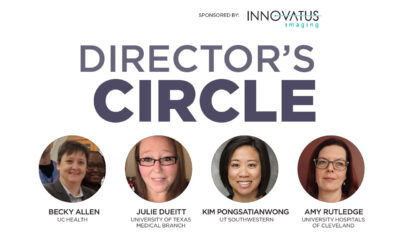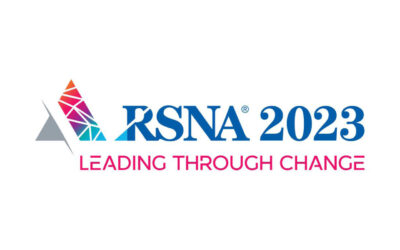 I’ve worked in health care for, well, a long time. People who work in our field know that certain constants remain the focus of what we do: Creating solutions for customer challenges, delivering stellar customer service and enabling the best possible patient outcomes.
I’ve worked in health care for, well, a long time. People who work in our field know that certain constants remain the focus of what we do: Creating solutions for customer challenges, delivering stellar customer service and enabling the best possible patient outcomes.
Now, forget everything else.
That’s because the “why” we do what we do will never change, but the “how” will never remain the same.
Beyond the Track Ball and Keys …
Remember the days of trackballs and keyboards for ultrasound machines? Hardware and manual controls have given way to software and high-resolution touch screens for both user display and user interfaces. The footprint of equipment is smaller and less obtrusive than ever before.
The smaller ultrasound footprint allows for greater portability. Just 10 years ago, all ultrasound machines were large. Today, we see devices that fit within the palm of your hand, such as the Vscan Extend, bringing health care to parts of the world that previously didn’t have access to medical imaging technology.
And that just scratches the surface.
To understand the future of service, we must understand the future of ultrasound.
We’re seeing technologies such as smartphones and tablets working with ultrasound probes. The probe is becoming increasingly complex and able to connect directly to consumer products.
… To the Cloud
And the biggest technology trends that will impact ultrasound and service are the abilities for devices to be connected digitally and to gather data for artificial intelligence, analytics and system surveillance. Equipment is becoming smarter all the time, gathering machine data and creating actionable insights that enable better clinical and operational outcomes.
One of the future capabilities will be around managing user presets. Through cloud-based management tools, biomeds and health care technology professionals will be able to store data and quickly deploy it across an entire fleet of equipment. This will even allow clinicians to share users’ presets with their peers.
Cloud data management will save biomeds time while driving standardization for hospitals and may even raise the level of care for ultrasound exams.
What are we talking about when we say machine data? First, we must have the ability to pull data from the system. This can be information such as temperature, power and log files.
We push that data real-time to a cloud-based server for storage and for visualization, so we can optimize staffing or understand capital equipment needs. Data could also be used to minimize equipment downtime by creating alerts and triggers for proactive failures.
The ability to measure data over time and to create smart algorithms could help us better understand how, why and when failures happen. In the future, we will be able to predict and know an ultrasound system is broken before it breaks.
Connected systems could change the way we service equipment. Traditionally, you would have to be at a console to diagnose and fix the equipment. In the future, more connected systems will help enable biomeds and health care technology professionals to maintain their entire fleet of equipment remotely. Web-based applications will be able to perform diagnostics, enable software deployment and even push software fixes.
The biomed of the future will be able to maintain an entire ultrasound install base from his desk or even through her smartphone.
From Analog to Digital
Just like technology in everything from automobiles to social media, probes are more complex than ever before. The future is now, as we’re seeing the “next generation” of probes today. And they’re built differently than in the past.
How do we know this? GE Healthcare has great visibility and insight into the entire life cycle of GE Healthcare equipment. We’re connected to the IoT as well as mobile devices. In fact, at AAMI this year, GE Healthcare displayed AR and VR, both driven by the same affordability factor of technology that we see in the consumer market.
Power to the People
The rapid evolution of ultrasound means our processes – and our people – are evolving, too.
One of the challenges specific to ultrasound, unique to other imaging modalities, is the size of the install base to manage. Ultrasound is a growing modality within hospitals, and biomeds are challenged with managing their growing equipment count. To add to the complexity, many larger hospitals might have multiple brands, multiple models for each brand, and even multiple generations of equipment. Just managing the install base alone can be frustrating, especially for larger sites.
And that dynamic is happening against the backdrop of generational change.
Today’s biomeds and related professionals have new ways of thinking, learning and working. They crave digital solutions and on-demand learning. They expect devices to be smarter. At the end of the day, they’re consumers of technology, too, whether we’re talking about using the newest smartphone, driving an AI-enabled vehicle or searching for a new show for binge-watching: We work the way we live.
Plus, more and more in-house programs across the country are managing and performing their own service and maintenance.
The Regulatory Environment…
The U.S. Food & Drug Administration (FDA) has issued draft guidance, called “Marketing Clearance of Diagnostic Ultrasound Systems and Transducers.”
What does it mean for OEMs?
As one aspect of changes proposed in this guidance, any filings after final release will need to include how we will implement appropriate testing of transducers.
GE Healthcare is committed to staying up-to-date as any new FDA guidance is issued or existing guidance revised and to internally evaluating process changes that might be needed.
Who’s In?
Nothing is constant except change. Equipment technology will advance; biomeds’ work styles will evolve. The questions to ask yourself are “Will you keep up? How?”
There’s really no option. Either you’re in or you’re left behind. OEMs should work closely with biomeds, field engineers and other, similar professionals to stay tightly aligned on what works and what doesn’t.
If I know anything about the people I work with who help support the services we provide for the health care equipment industry, it’s that we’re committed: Committed to producing solutions for customer challenges, delivering stellar customer service and enabling the best possible patient outcomes. And, those things will never change.
– Gary Bobb is the general manager of GE Healthcare Service.







